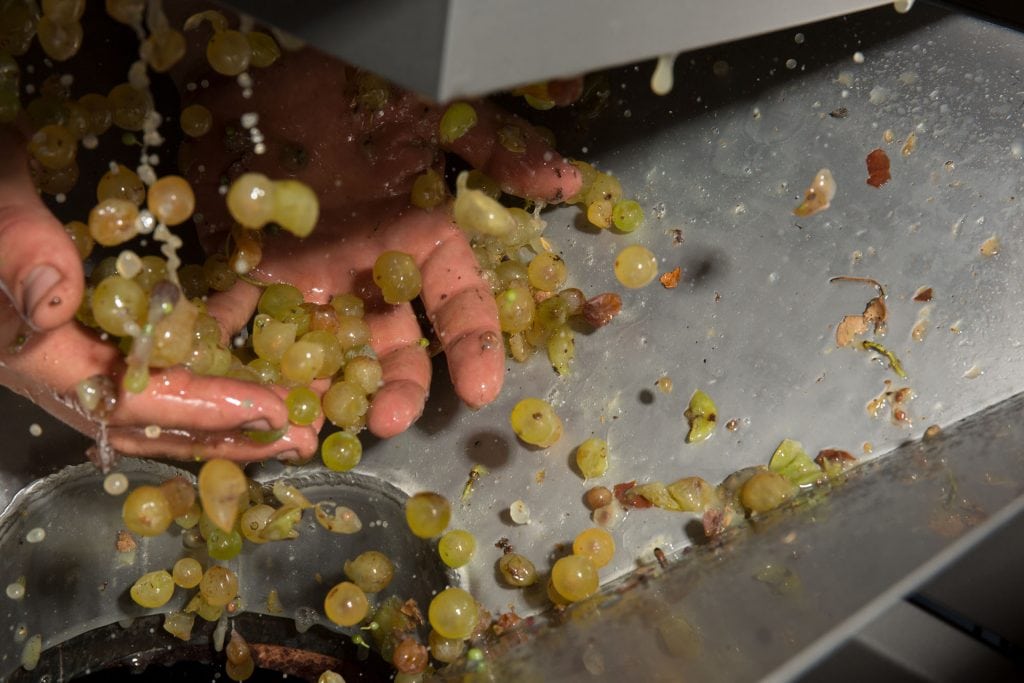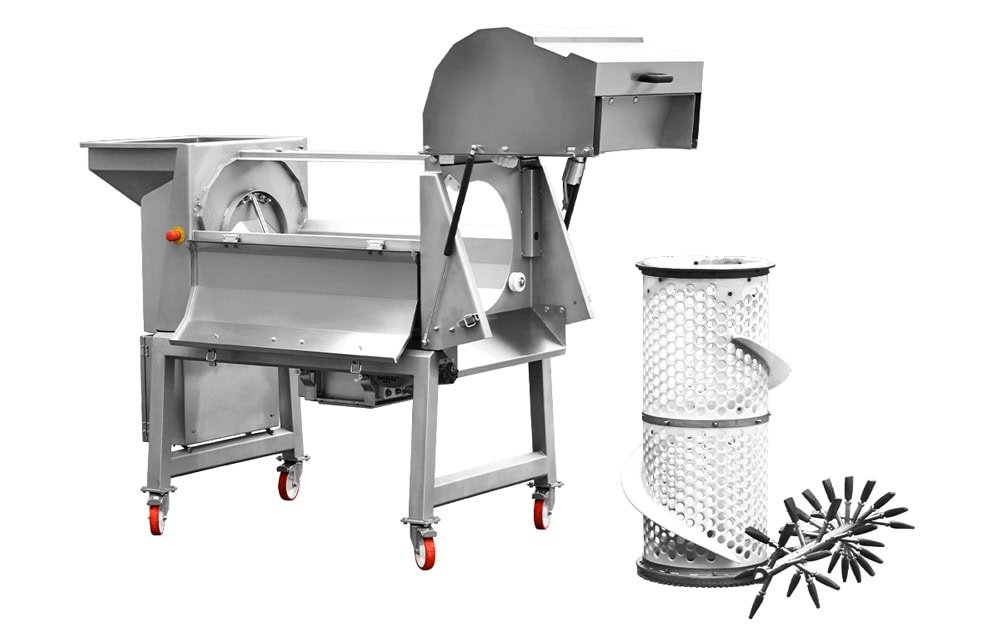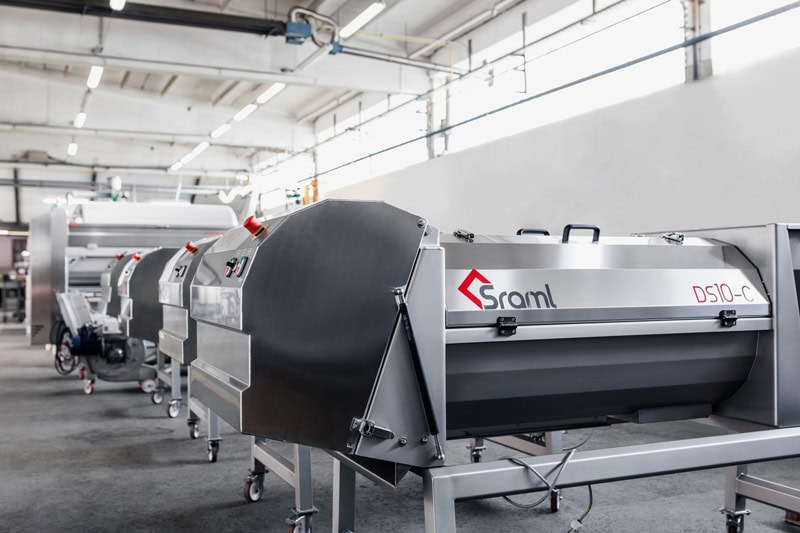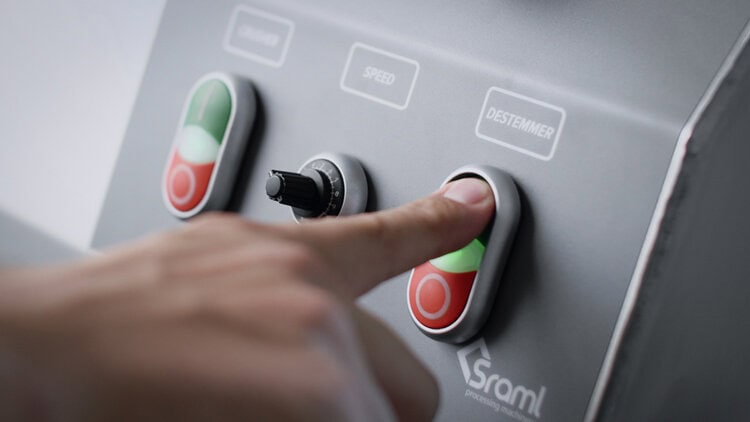Destemming and Crushing

Destemming and crushing grapes are generally intertwined and almost unavoidable operations in winemaking technology, their primary function is to remove the grape berries from the stems and release the grape juice from the skin barrier of the berries. Both processes are carried out by means of a combined machine unit at the reception of grapes into the cellar.
Both destemming and crushing grapes tend to be rather overlooked as they appear simple, and are performed mechanically and on a large scale. With this in mind, SRAML experts have compiled some useful tips and instructions to follow during the destemming and crushing process.
Destemming: What to bear in mind
Destemming is carried out as soon as the grapes are harvested to prevent the heating and activity of undesirable micro-organisms such as bacteria, molds, and yeasts. Although destemming is a near-essential procedure in winemaking, the consequences of stem presence must be understood. As a result, when deciding whether or not to perform the destemming procedure, it is necessary to consider the following findings:
- Stem mass adds 30% to the volume of the procedure, requiring a larger-volume press and increasing the procedure’s economic value
- The presence of stems is recommended when pressing Botrytis-infected grapes since they help to protect wine hues, inhibiting the enzyme laccase* and its activity
- As a result, destemming raises the wine’s alcohol content and total acidity. As the stems contain some water and very little sugar, they lower the wine’s final alcohol content. What is more, they have a high potassium content and make the must alkaline. The presence of stems thus impacts the chemical composition of the wine, as illustrated in the Table below
- The presence of stems in the fermenting mash is also an additional source of phenolic compounds. Grape skins represent the largest source of total phenols (55%), followed by seeds (25%) and, finally, the stems, which increase the concentration of total phenolic substances by an additional 20%
| Chemical parameter | Wine produced by destemming | Wine produced without destemming |
|---|---|---|
| Alcohol level (%) | 13,2 | 12,7 |
| Total acidity (g/L) | 8,69 | 7,8 |
| Volatile acidity (g/L) | 1,14 | 1,14 |
| Total polyphenols | 38 | 58 |
| Colour intensity | 1,28 | 1,18 |
| HUE | 0,51 | 0,57 |
* Laccase- p-phenol oxidoreductase, a fungal enzyme contained in Botrytis[1]infected grapes. It is stable at typical wine pH levels and resistant to sulfur dioxide. It hastens and triggers several oxidative processes. Laccase-containing wines bind a large amount of sulfur dioxide.
“The primary reason that destemming is done before crushing is to prevent the extraction of undesirable phenols from the stem. Phenols derived from stems are often more astringent and bitter than phenols derived from skin or seeds.”
D. Bavčar, Kletarjenje danes [Winemaking Today]

Horizontal destemmers are composed of a rotating perforated cage and a destemming shaft with flat tips positioned longitudinally in the cage. When grape enters the cage via the receiving hopper, the destemming shaft with the levers starts rotating them along the perforated surface. The berries split through the apertures as the destemmer rotates, while the stems move along and fall out at the back.
It is important that the process of separating berries and stems is performed without causing damage to the stems and berries. The juice extracted from the cellular vacuoles of green tissue is bitter and astringent; it is mostly composed of flavonoids and lignin, which degrades into aldehydes, affecting the quality of future wine. Grape destemmers with rigid metal designs or destemmers that require high spinning speeds to separate berries should be avoided in modern winemaking.

A high-quality destemmer protects the grape berries and completely removes them from the stems. In the new SRAML D-type destemmer series, the stainless[1]steel cage has been replaced with a polyethylene one while rubberized, inclined, and length-adjustable tips have been added to the destemmer shaft.
The cage and destemmer shaft both rotate in the same direction, increasing the shaft’s speed by nine times. The same rotational direction considerably reduces stem breakage and berry damage since the action of shearing or pinching between the cage and the destemmer shaft is almost eliminated. The opposite rotational direction of the cage and the destemmer shaft makes it easier to separate the berries from the stems, yet the damage to the stems and berries is significantly greater. The rotation speed is controlled by a frequency regulator and has a linear effect on the rotation of both sections simultaneously. The destemmer can be adjusted according to the physiological condition of the grapes to enable complete separation of the berries without damaging or breaking the stems by regulating the pace.

The design and structure of a high-quality polyethylene cage is essential. At SRAML, we have paid particular attention to the size, layout, and quality of the basket perforation to separate the berries from the stems as gently and efficiently as possible
Such a novel approach to destemming effectively prevents:
- berry juice secretion and the risk of oxidation,
- stem breakdown and unintended extraction of vegetable saps,
- soaking the stems in juice, which decreases the possibility of economic losses
The significance of crushing in wine quality
Crushing the grape berries releases the juice and flesh from the skin barrier, influencing the maceration effect, accelerating fermentation and avoiding residual sugar in press wine. Care must be taken to avoid damaging the grape tissues during the crushing procedure since damage to berry skins would accelerate tannin extraction, leaving the wine with an undesirable herbal character and astringent taste.
Crushing and mechanical damage to grapes are common reasons why many winemakers choose to avoid the crushing operation. A high-quality crusher simply needs to squeeze the berry sufficiently to let the juice pour out.
“Above all, avoid crushing the seeds since the oxidation of their oils produces rancid aromas.”
D. Bavčar, Kletarjenje danes [Winemaking Today]
Crushers are typically made up of two opposingly revolving grooved rollers that squeeze the berries to separate the juice and flesh. During the crushing process, close attention should be paid to the spacing between the rollers, which is regulated by the size of the grapes. By adjusting the distance between the rollers, most of the grapes are crushed, while smaller berries can be left whole.
SRAML crusher upgrades feature additional grooved rollers covered by a thick layer of soft rubber and a system for easy distance adjustment. As a result, the crushing is adjusted to the size of the berries, allowing for regulated berry crushing throughout the process without risking damage to berry skins or seeds.

The following factors should be considered while deciding on a crushing procedure:
- Improved drainage and additional draining capacity.
- A more cost-effective pressing method:
- without continuous draining, the press can hold up to 50% more grape mass;
- with continuous draining of the must from the press, the press can hold up to 300% more grape mass. Pressing the mash takes less time than pressing whole grapes due to greater mass per cycle.
- Crushing allows pumping of the grape mass and a more uniform addition of oenological aids and sulfur dioxide.
- The ratio between the surface of exposed berry skins and the volume of released juice is larger, creating more favorable conditions for the release of aromatic compounds. Cold maceration under regulated conditions facilitates the extraction of aromatic components from the grape berry exocarp and mesocarp.
- Crushing improves the extraction of the coloring matter and tannins significantly. It accentuates the anthocyanin and tannin dissolution, which can be further intensified by energetic crushing. Tannin dissolution is facilitated by crushing, leading to higher color stability of wine.
- While mash maceration subjected to a more intense physical impact does have some advantages, wines produced in this manner tend to be of a harsh and “green” character, pronounced as more astringent and less pleasant to the taste.
- Crushing introduces oxygen into the grape mass. Dissolved oxygen combined with synchronous yeast inoculation contributes to a faster onset of fermentation as well as a faster increase in fermentation temperature. The proportion of whole berries can be preserved in order to keep the fermentation temperature lower (carbon maceration).
- Use caution while introducing oxygen, especially in the production of white wines. It should also be avoided if the grapes are infected with Botrytis or rot.
- The mash ferments faster and more uniformly. During the pressing process, young wine contains less residual sugar.
- The drawback is that the juice has a higher proportion of dissolved compounds and is more turbid.
As discussed above, a more intensive crushing can increase the effect of coloring and phenolic compound extraction; however, this can be substituted by methods such as modifying the maceration time, the interval of pumping over, and temperature management. All important factors contribute to wine quality. Extending the maceration time usually substitutes the effect of vigorous crushing and minimizing mechanical tissue damage.

In winemaking, superior hygiene and the time required to clean the equipment are crucial. SRAML has found the answer to quick and thorough cleaning to meet winemakers’ needs.
Paying close attention to detail, SRAML has designed the new destemmer line by reducing the number of concealed edges and increasing accessibility for interior cleaning. Lightweight polyethylene parts lessen the winemaker’s labor in disassembling and reassembling the machine while also greatly facilitating the cleaning process.

Purchasing new equipment requires careful consideration and great responsibility on the part of the winemaker, with quality advice being a valuable asset. The SRAML expert team provides a dedicated support service, assisting you with the destemmer selection and developing customized solutions specific to your business needs.
You might also be interested in our article about the history of the wine press.
Elaborated by Marko Benčina, B.Sc. in Viticulture and Enology
